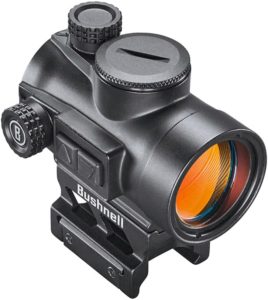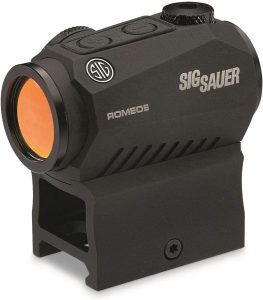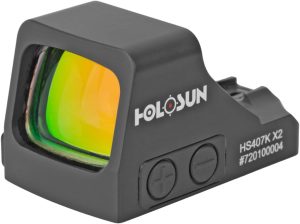Red dot sight projects an illuminated dot that appears to be floating on your target.
You don’t have to align rear and front sights; instead, you simply place the dot where you want your shot to land.
Its simplicity is its brilliance.
Inside, a red dot sight uses a combination of lenses and reflective materials to create this effect.
But How Do Red Dot Sights Work? Let’s find it out.
Table of Contents
How Red Dot Sights Work: A Step-by-Step Guide
First, turn on the sight.
A small LED inside creates a red light.
This light hits a specially coated lens that reflects the red light back towards your eye.
Now, look through the sight. You’ll see a red dot.
But here’s the trick: the dot doesn’t actually move. It stays in place on the lens.
When you move your head, the dot seems to stay on target.
That’s because the lens is angled.
It makes the light bounce straight back at your eye, no matter where your eye is.
Aim the dot at your target.
As long as the sight is mounted properly, your shot should hit where you see the dot.
Don’t worry about lining up iron sights. Just put the red dot where you want the bullet to go.
Lastly, remember the red dot sight is simple to use. It’s quick to aim and doesn’t need much adjustment.
Practice with it, and you’ll find it helps you shoot faster and with more accuracy.
Types of Red Dot Sights
Full-sized red dot sights are the most common.
They’re big and easy to use. You put them on rifles for better aim.
They often have a wide field of view, which helps you see more around the target.
Miniature red dot sights (MRDS) or micro red dots are smaller.
They’re light and work well on pistols or as a backup sight on a rifle.
Even though they’re tiny, they still help you aim quickly.
Reflex sights are a type of red dot sight that uses a simple lens and a light-emitting diode (LED).
The LED shines a dot onto the lens, which you then see as the aiming point. These are user-friendly and quick to use.
Holographic sights project an image onto a glass pane in the sight.
They’re high-tech and work well in different light conditions.
Plus, they can help you aim even when you move your head.
Each type has its own pros and cons. Think about what you need before you pick one.
Advantages of Using Red Dot Sights
With red dot sights, aiming at targets is faster and more intuitive than with traditional iron sights.
These sights help you shoot with both eyes open, which means you’ve got a wider field of view.
You can see more around you, and it’s easier to follow moving targets, too.
Red dot sights don’t have complex reticles. Just a simple dot.
This means you don’t have to align front and rear sights. Just put the dot where you want to hit.
That’s it. This simplicity lets you aim quickly. It’s great for high-pressure situations.
They also work in low light. Iron sights are hard to see when it’s dark.
Red dots light up, so you can see the dot against dark backgrounds.
This is a big plus for hunting at dawn or dusk.
And here’s another thing. Red dots are forgiving. If you move your head, the dot stays on target.
With iron sights, if you’re not lined up just right, you’ll miss. Red dots give you more room for error.
Common Misconceptions and Clarifications
First off, you might think a red dot sight projects a laser onto the target. It doesn’t.
The dot you see? It’s actually a reflection, just for your eye.
Others can’t see it. Another mix-up is about power. Red dot sights don’t help you shoot farther.
They make aiming quicker and easier, that’s all.
Some folks also get it wrong about the red dot itself. They think it shows bullet impact.
Nope, it only shows where your barrel points. You still have to factor in things like wind and distance.
And if you’ve heard they’re only for pros, that’s not true either. Red dot sights are great for beginners too.
They’re simple and user-friendly.
Lastly, don’t be fooled into thinking all red dot sights are the same.
They’re not. Sizes, shapes, and features vary, so you’ll have to pick one that suits your needs.
Red Dot Sight Vs. Iron Sights and Telescopic Sights
Iron sights are the classic, simple aiming tools on a gun.
You’ve got a notch at the back and a post in the front.
Line them up, and that’s where your shot should hit.
They’re tough and don’t rely on batteries, but they’re not great in low light.
Now, red dot sights are different. They project a red dot as an aiming point.
It’s much quicker to use. You just look through the lens, spot the dot, and aim.
No lining up is needed. Plus, they work well in dim conditions.
But, remember, they need power, so keep those batteries handy.
Telescopic sights, or scopes, give you a zoomed-in view. They’re perfect for long shots.
You can see far and aim with precision.
But, they’re bigger, can be heavy, and take more time to line up a shot compared to red dots.
Red Dot Sight Models and Variations
Red dot sights come in various shapes and sizes, each with features to suit different preferences and firearms.
Small, compact models are perfect for handguns, as they are light and don’t add much weight.
Then, there are larger ones for rifles. They offer a broader view, which helps you spot targets faster.
Some red dot sights have a tube design. It looks like a short telescope.
This type helps you focus and cuts out distractions.
Others are open style. They’ve just a small piece of glass.
This type gives you a wider view. It’s easier to use with both eyes open.
You also get to choose how the dot looks. Some dots are tiny.
They’re great for hitting small targets far away. Others have a bigger dot.
These are quicker to see, which helps in fast shooting.
Brightness can change, too. In bright sunlight, you’ll need a stronger dot to see it clearly.
In the dark, a dim dot is better. Many red dot sights let you adjust the brightness to match the light around you.
Tips for Using Red Dot Sights Effectively
First, you’ll need to zero in your sight.
This means adjusting it so your point of aim matches the point of impact at a certain distance.
Start close, maybe at 25 yards, and make small adjustments until you’re on target.
Keep both eyes open when you aim.
This helps with peripheral vision and depth perception.
It’ll feel odd at first, but stick with it. It’ll improve your reaction time.
Next, focus on the target, not the dot. Let the red dot sit on top of the target in your view.
It’s like pointing with your finger – don’t stare at your finger, look at what you’re pointing at.
Remember to maintain a consistent shooting stance.
Your body position can affect where the bullet goes. Stand firm, breathe, and squeeze the trigger gently.
Just make sure your gun is unloaded and you’re pointing it safely.
The more you use your red dot sight, the better you’ll get.
Keep it simple, and you’ll see improvement.
Conclusion
Now you’ve got the scoop on red dot sights.
They’re simple but clever, using reflected light to help you aim fast.
Keep yours clean, and it’ll serve you well, whether you’re shooting for fun or in competition.
Remember, they’re not the same as iron or telescopic sights, but each has its place.
With a bit of practice, you’ll find red dots are a game-changer.
So, go on, give ’em a try, and see the difference for yourself.



